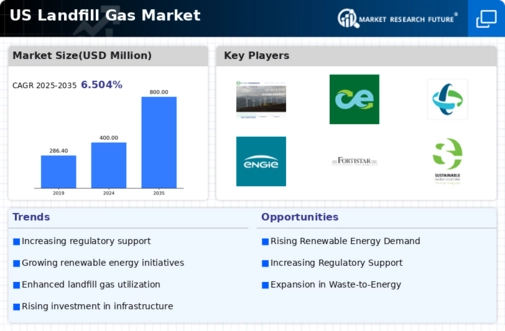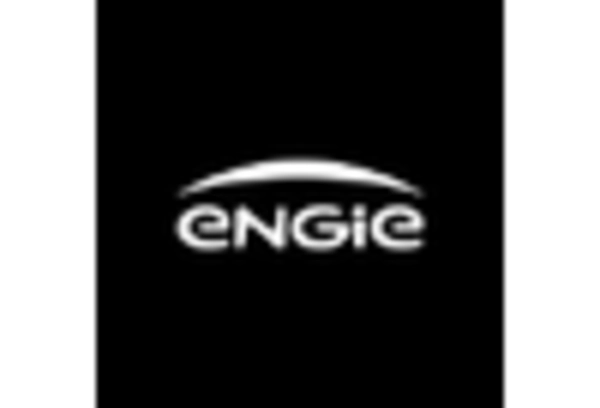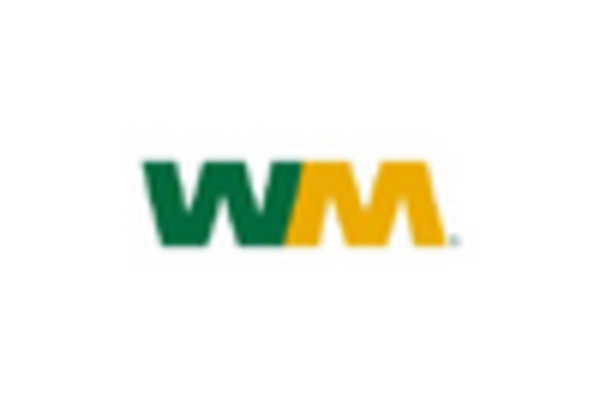Increasing Energy Costs
The rising costs of traditional energy sources are driving interest in alternative energy solutions, including the landfill gas market. As fossil fuel prices fluctuate, municipalities and energy producers are increasingly looking to landfill gas as a cost-effective energy source. The landfill gas market benefits from this trend, as it provides a renewable energy option that can help mitigate the impact of rising energy costs. In 2025, the average price of natural gas in the US is projected to be around $3.50 per million British thermal units (MMBtu), making landfill gas an attractive alternative for energy generation. This shift towards more sustainable energy sources is likely to enhance the growth of the landfill gas market, as stakeholders seek to reduce their reliance on conventional energy sources.
Environmental Regulations
Stringent environmental regulations are shaping the landfill gas market in the US. The Environmental Protection Agency (EPA) has implemented various regulations aimed at reducing greenhouse gas emissions from landfills. These regulations encourage the capture and utilization of landfill gas, which contains methane, a potent greenhouse gas. Compliance with these regulations not only helps in reducing emissions but also opens up opportunities for energy generation. In 2025, it is estimated that approximately 50% of landfills in the US will be equipped with gas collection systems, significantly boosting the landfill gas market. This regulatory landscape is likely to drive investments in landfill gas projects, as companies seek to align with environmental standards while capitalizing on the economic benefits of gas recovery.
Technological Innovations in Gas Utilization
Advancements in technology are playing a crucial role in enhancing the efficiency of gas recovery and utilization in the landfill gas market. Innovations such as improved gas collection systems and more efficient conversion technologies are enabling better extraction and use of landfill gas. For instance, the introduction of high-efficiency gas engines and turbines has increased the energy output from landfill gas, making it a more viable energy source. In 2025, the efficiency of gas-to-energy systems is expected to improve by approximately 15%, further solidifying the landfill gas market's position in the renewable energy sector. These technological improvements not only enhance the economic feasibility of landfill gas projects but also contribute to the overall sustainability goals of energy producers.
Public Awareness and Support for Sustainability
There is a growing public awareness regarding sustainability and the importance of renewable energy sources, which is positively impacting the landfill gas market. As communities become more informed about the environmental benefits of utilizing landfill gas, there is an increasing demand for projects that harness this resource. Public support for sustainability initiatives often translates into local government backing for landfill gas projects, facilitating smoother project approvals and funding opportunities. In 2025, surveys indicate that over 70% of Americans support the development of renewable energy projects, including those focused on landfill gas. This heightened awareness and support are likely to drive further investments in the landfill gas market, as stakeholders recognize the potential for both environmental and economic benefits.
Economic Incentives for Renewable Energy Projects
Economic incentives provided by federal and state governments are significantly influencing the landfill gas market. Programs such as tax credits, grants, and renewable energy certificates are designed to encourage the development of renewable energy projects, including those that utilize landfill gas. In 2025, it is projected that the federal investment tax credit for renewable energy projects will remain at 30%, providing a substantial financial incentive for landfill gas projects. These economic incentives not only lower the initial investment barrier but also enhance the overall return on investment for stakeholders involved in the landfill gas market. As financial support continues to grow, it is likely that more landfill gas projects will be initiated, further expanding the market.

















Leave a Comment